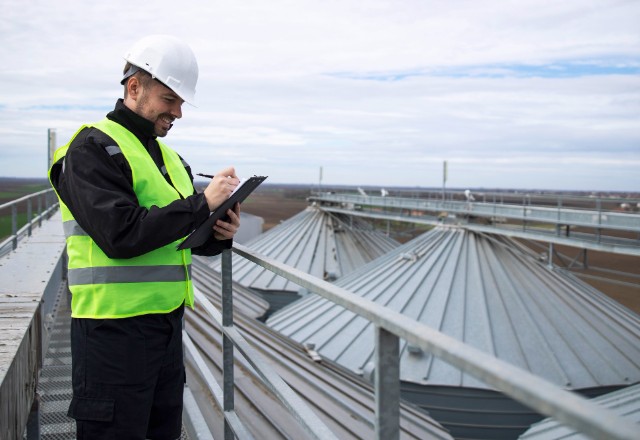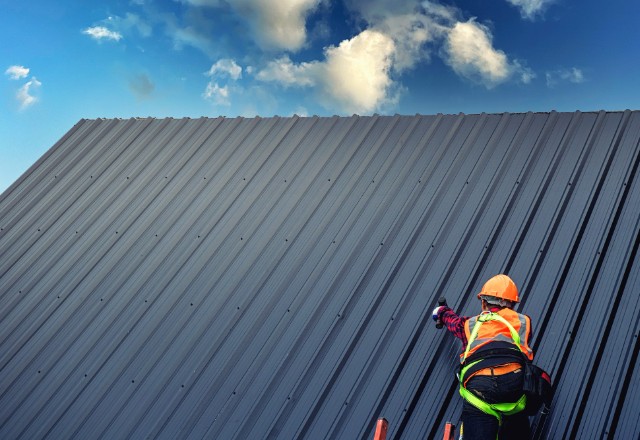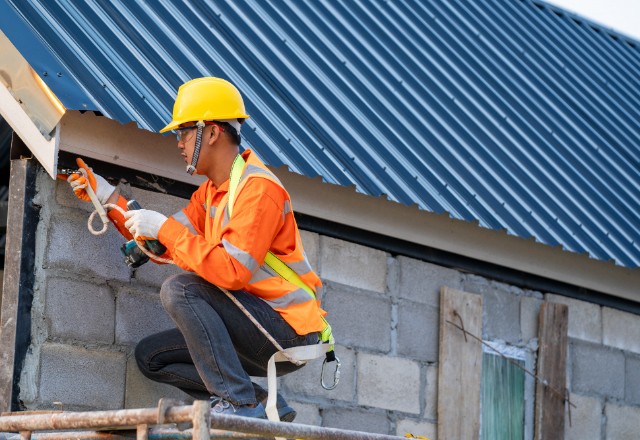Metal roofing is a durable and cost-effective solution for any residential or commercial building, but it’s only as strong as its installation. From selecting the right materials to understanding weatherproofing tips, mastering the basics of metal roofing installation takes knowledge and skill. Whether you’re a homeowner looking to upgrade your home’s aesthetic or a business needing to protect its investments, this guide will provide you with professional installation tips that will help you achieve metal roofing mastery.
Disclaimer: This article is for reference only and does not constitute professional advice. While some of the tips provided here may help improve your metal roofing project, it is highly recommended that you seek professional consultation from a qualified contractor before beginning any installation. Advance Roofing LLC has been proudly providing the Spokane, WA area with the highest quality roofing solutions for many years and is always happy to assist with any questions or concerns you may have. For more information on metal roof installation and repair, please visit advanceroofingllc.com or contact us directly!
What is Metal Roofing?
Metal roofing is an attractive and reliable choice for residential and commercial buildings. It provides lasting protection from the elements, and can last up to 50 years with proper maintenance. Metal roofing is also energy efficient, reflecting heat away from the structure to help keep it cool in the summer months. It’s available in a range of styles, textures, and colors to fit any aesthetic. Plus, metal roofs are fire-resistant and don’t require frequent repairs like other types of roofing materials. Whether you’re looking for a traditional look or something more contemporary, metal roofing has something that will fit your needs.
Metal roofing is the perfect solution for any building, providing a strong, reliable roof that will last for years. Get ready to learn more about the many benefits of metal roofing – including energy efficiency and fire resistance – in the next section!
Benefits of Metal Roofing
Metal roofing is an excellent choice for homeowners and businesses looking for a reliable and long-lasting roof. Its durability, energy efficiency, and fire resistance make it an ideal option. Metal roofs are also available in a range of styles, textures, and colors to fit any aesthetic.
The biggest benefit of metal roofing is its longevity; with proper maintenance, metal roofs can last up to 50 years! This makes them a great investment as they’re unlikely to need frequent repairs or replacement like other types of roofing materials.
Not only that, but metal roofs are also highly energy efficient. They reflect heat away from the structure in the summer months to help keep it cool without needing additional insulation.
Finally Fina, metal roofs are fire-resistant, offering added protection for your home or business and peace of mind knowing that your building is well protected from potential fires.
All these advantages make metal roofing a great choice for any type of building.
Differences Between Residential and Commercial Projects

There are notable distinctions between metal roofing projects for residential and commercial buildings. Residential projects are typically smaller in scale, with less complex designs and fewer materials required. As a result, installation costs tend to be lower than for commercial projects. On the other hand, commercial projects often involve larger-scale installations with more intricate designs, additional accessories like vents and skylights, and the use of specialized tools or equipment. This can result in higher installation costs but also superior performance and increased durability over time.
In addition to size and complexity of the job, homeowners should also consider the local climate when deciding on a metal roofing system. For instance, some systems may be better suited for areas with extreme temperatures or high winds while others may be more suitable for mild climates. Finally Fina , if your project involves multiple levels or complicated angles, you may want to work with a professional metal roofing contractor who has experience installing these types of roofs – it will help ensure your project is completed correctly and efficiently.
A metal roof can be a great choice for any home, but it’s important to consider the size, complexity and climate of your project before making a decision. When selecting your system, make sure you get the help of an experienced professional to ensure your roof is installed properly. Now let’s take a look at some of the different types of metal roofs available for residential projects.
Types of Metal Roofs for Residential Homes
When it comes to metal roofing for residential homes, there are a variety of options available. From standing seam panels to corrugated sheets, metal roofs come in a wide range of styles and designs to suit any home.
Standing seam panels are popular because they are exceptionally durable and provide superior protection against wind and water damage.
Corrugated sheets have the advantage of being lightweight yet strong, making them ideal for sloped roofs or projects with multiple levels.
Additionally, metal shingles offer an attractive option that can mimic the look of traditional asphalt shingles but with the added benefits of increased durability and longevity.
No matter which type you choose, make sure you work with a professional metal roofer who has experience installing these types of roofs – it will help ensure your project is completed correctly and efficiently.
Types of Metal Roofs for Commercial Buildings
When it comes to metal roofing for commercial buildings, there are several options to choose from. Standing seam panels provide superior protection against wind and water damage, making them an ideal choice for flat or low-sloped roofs. Corrugated sheets offer a lightweight yet strong solution that is well-suited for larger projects with multiple levels. On the other hand, metal shingles are perfect for achieving a traditional asphalt shingle look with increased durability and longevity. Additionally, you can opt for a more modern look with standing seam panels in various colors and textures to match your building’s aesthetic. Whichever option you choose, make sure you hire a professional metal roofer who has experience installing these types of roofs – it will help ensure your project is completed correctly and efficiently.
Cost Considerations

When it comes to metal roofing, the cost is an important factor to consider. Generally speaking, metal roofs are more expensive than traditional asphalt shingle roofs. However, this difference in price pays off in the long run as metal roofs last longer and require less maintenance and repairs. Moreover, some metal roof varieties also come with energy efficiency benefits that can help reduce your monthly bills. Additionally, you should factor in the cost of professional installation when budgeting for your new roof – proper installation is essential for ensuring that the roof functions correctly and lasts as long as possible. All in all, while metal roofs may be initially more costly than traditional asphalt shingle options, they offer a range of benefits that make them well worth their upfront expense.
Metal roofs may cost more upfront, but they offer a range of benefits that make them a worthwhile investment. Ready to learn more about the average costs for metal roof installation? Read on!
Average Costs for Metal Roof Installation
The cost of metal roof installation is influenced by several factors including the metal type, roof size and complexity, and location. Generally speaking, steel or aluminum roofs tend to be more expensive than copper or zinc varieties. Additionally, labor costs can vary widely depending on whether you hire a professional contractor or attempt DIY installation.
On average, professionally installed metal roofs typically range from $5 to $20 per square foot for materials and labor. Copper and zinc options tend to be at the higher end of this range due to their higher prices for materials. Furthermore, complex roofs with tricky angles and slopes may also incur additional labor costs. Ultimately, it’s best to get multiple estimates from contractors in your area before making any decisions.
Overall, while metal roofs are generally more expensive than traditional asphalt shingle options upfront, they offer many benefits that make them well worth the initial expense – increased durability and energy-efficiency being just two of them!
Additional Costs to Consider with a Metal Roof Installation
When considering a metal roof installation, there are several additional costs to keep in mind.
First and foremost, the materials used can add to the overall cost of the project. While steel or aluminum roofs tend to be more expensive than copper or zinc options, they also offer increased durability and energy efficiency.
Furthermore, if you plan on hiring a professional contractor for the installation process, this will also incur an additional cost that should be taken into account.
Finally, complex roofs with tricky angles and slopes may require additional labor costs as well.
Ultimately, it’s best to get multiple estimates from contractors in your area before making any decisions so you have a clear understanding of all associated expenses.
Installation Process: Step-by-Step Overview

Installing a metal roof is no small feat, so it’s best to be well-prepared before you begin.
To start, make sure that your subroof is in good condition and that any existing shingles are removed.
Next, install the drip edge, ice & water shield (or felt paper) as needed.
After that, you’ll need to install the starter strips along the eaves and rake edges of your roof.
Then you’re ready to begin laying down your panels.
Make sure to secure each one with fasteners— typically screws—before moving on to the next panel.
If applicable, you can also use sealant or caulk along seams for extra protection against moisture and debris.
Finally, once all panels are secured in place, finish up by installing ridge caps at each peak of your roof and flashings around protrusions such as vents and pipes.
With these steps completed, your metal roof will be ready for years of reliable service!
Congratulations; you now have the knowledge and steps needed to successfully install a metal roof! With the right preparation, you can expect your roof to last for years to come. Now that you know what it takes to get started, let’s dive into the preparation steps before installing the metal roof – stay tuned for more details!
Preparation Steps Before Installing the Metal Roof

Before you can begin installing your new metal roof, there are some important preparation steps to take.
Start by checking your subroof for any damage or rot that might interfere with the installation process. If any issues are found, they should be addressed before proceeding.
Once the subroof is cleared, you’ll need to make sure that all existing shingles and other materials are removed from the roof surface.
Finally, inspect the area around protrusions such as vents and pipes to ensure that any flashings needed will be properly installed during the roofing process.
With these steps completed, you’ll be ready to begin installing your new metal roof! Taking time for proper preparation is key when it comes to a successful installation—so don’t skip out on these essential steps. With careful planning and attention to detail, you can achieve metal roofing mastery in no time!
Installing the Underlayment and Gutters/Drains
It’s time to move on to the next step in your metal roofing installation: installing the underlayment and gutters/drains. Starting with the underlayment, you’ll need to make sure it is properly laid out and overlapped correctly. This will help provide an extra layer of protection against water damage and ensure that your roof is secure. Next, you’ll need to install the gutters and drains in order to direct rain water away from your home. Installing these components properly can help prevent water-related damage and maintain a healthy roof system for years to come!
When selecting materials for your gutter system, make sure to choose ones that are made from corrosion-resistant metals in order to prevent rust or decay over time. Additionally, when attaching the gutter pieces together, be sure to use sealant or silicone caulk at all joints in order to form a strong seal against weather elements. With proper installation techniques, you can achieve metal roofing mastery like a pro!
Installing the Panels or Shingles and Fasteners
Once you’ve completed the underlayment and gutters/drains, it’s time to move on to the fifinal step in y na our metal roofing installation—installing the panels or shingles and fasteners. It is important to properly place and secure each panel or shingle in order to ensure a strong, secure roof system. When securing each panel or shingle with fasteners, make sure to use galvanized nails or screws that are corrosion-resistant and long enough to penetrate through both the panel and underlying sheathing. Additionally, when using self-tapping screws, be sure not to over-tighten them as this can cause unnecessary stress on the material and ultimately weaken it. With proper installation techniques, you can achieve metal roofing mastery like a pro!
Finishing Touches After the Metal Roof is Installed
Once the metal roof is installed, it’s time to finish up the project with some final touches.
To start, apply a sealant or caulk around any penetrations such as vents and pipes. This will help prevent water leaks and give your structure a finished look.
You should also inspect all of the fasteners used during installation to make sure they are secure and not exposed.
If any are loose, replace them with corrosion-resistant screws or nails that match the material you used for your roofing system.
Finally, if necessary, apply a coat of paint on top of the metal panels to protect them from UV rays and other weather elements.
Taking these extra steps will ensure that your metal roof stays in great condition for many years to come!
Maintenance Tips to Ensure Long-Term Performance of Your Metal Roof

Maintaining your metal roof is essential for ensuring its long-term performance.
To start, it’s important to clean the surface of your roof regularly to remove debris and keep it looking great. You should also inspect your roof periodically for any signs of damage such as corrosion or leaks. If you notice any issues, take immediate action to fix them.
Additionally, check the fasteners used during installation and make sure they are still secure.
Finally, apply a coat of protective paint to your metal panels every few years in order to protect them from UV rays and other harsh weather elements.
By taking these simple steps, you can ensure that your metal roof remains in top condition for many years to come!
Proper maintenance of your metal roof is essential for ensuring that it looks and performs its best. By taking the steps outlined above, you can ensure that your metal roof will remain in top condition for many years to come. Regular inspections and cleanings are also key to maintaining a quality condition – learn more about these important steps in the next section!
Regular Inspections & Cleanings to Maintain Quality Condition

Regular maintenance, including inspections and cleanings, is necessary to ensure the continued quality of a metal roof.
Periodic inspections should be done to check for signs of corrosion, leaks, or damage. If any issues are found, they should be addressed immediately.
Additionally, cleaning your metal roof on a regular basis is essential for removing debris and keeping it looking its best. Depending on the type of metal roof you have installed, you may need to use a soft brush or sponge with mild soap and water to remove dirt and dust buildup.
Finally, applying a coat of protective paint every few years will further protect your metal panels from UV rays and other harsh weather elements.
By taking these steps, you can ensure that your metal roof remains in top condition for many years to come!
Weatherproofing Tips & Strategies to Protect Against Harsh Conditions Weatherproofing your metal roof is essential for protecting it against harsh conditions.
One of the best ways to do this is to ensure that all seams, joints, and flashing are properly sealed with a high-quality sealant or caulk. This will help protect against moisture and prevent the development of rust or other damage.
Additionally, applying a special sealant or coat of paint to exposed surfaces can help protect them from UV rays and other weather elements.
Finally, regular inspections should be conducted to check for any signs of wear or damage that may require repairs.
By following these simple steps, you can keep your metal roof in tip-top shape for years to come!
Properly weatherproofing your metal roof will help protect it from the elements and keep it looking great for years to come. And if you want to take your protection a step further, be sure to stay tuned for our next section on how to best prepare your home or building for heavy snow and rainfall!
How to Prepare Your Home or Building for Heavy Snow and Rainfall

Heavy snow and rainfall can be extremely damaging to your home or building if you’re not properly prepared. The best way to protect your investment is to ensure that your roof is in good condition and can handle the additional weight of the snow and rain.
Start by inspecting the roof for any signs of wear or damage, such as missing shingles, loose nails, or cracked flashing; these should be fixed as soon as possible.
Additionally, it’s important to ensure adequate drainage so that water can run off rather than pooling on the roof. If necessary, add gutters or downspouts around the perimeter of the building to help channel water away from critical areas.
Finally, be sure to inspect any trees near your property; dead branches can easily break off during a storm and cause serious damage to your home or building.
With these precautions in place, you can rest assured knowing that your property will be safe and sound no matter what Mother Nature throws its way!
Understanding Insurance Policies & Coverage Options Related to Your Roofing Project
Gaining knowledge about insurance policies and coverage options regarding roofing projects can be a challenging endeavor. That’s why it’s important to do your research before beginning any work on your home or building.
Start by contacting your insurance provider for details about what is covered in the event of an accident or other damage during the installation process.
You should also ask about any discounts that may be available for certain materials, such as metal roofing, which is often more durable and less prone to damage than other types of roofs.
Additionally, you should inquire about additional coverage options that may provide extra protection against extreme weather conditions, such as heavy snow or hail storms.
Finally, make sure you understand the terms and conditions of the policy before signing any paperwork; this will ensure that all parties are aware of their rights and responsibilities in the event of unforeseen circumstances.
With these tips in mind, you can confidently embark on your roofing project knowing that your home or building is properly protected!
Now that you have the basic understanding of roofing insurance policies and coverage options, it’s time to move on to the next step in your roofing project: finding the right contractor for the job. But before you start work, make sure to ask the right questions to ensure you get the best results for your home or building. Read on for our top tips on choosing a reliable contractor!
Choosing the Right Contractor for Your Project – Questions to Ask Before Starting Work on Your Home/Building

Selecting a suitable contractor for your roofing project is crucial for attaining optimal results. Before signing on with any company, make sure to ask them a few key questions.
First, inquire about their experience and expertise in metal roofing; this is an important factor when it comes to ensuring that your home or building is properly protected. Ask if they have references or reviews you can look at to get a better idea of what kind of work they do and how reliable they are.
Additionally, make sure to ask about the cost of materials, labor, and any additional services they may offer. Be sure to also enquire about warranties and guarantees—this will help protect you in case anything goes wrong during the installation process.
Finally, ask for an estimated timeline so you know exactly when the job should be completed by.
With these tips in mind, you can find a reliable contractor who will ensure your metal roofing project is completed successfully!
By doing your due diligence and asking the right questions, you can ensure that your metal roofing project is in the hands of a knowledgeable and experienced contractor. With their help, you’ll be able to reap the benefits of professional installation for maximum efficiency and durability – but more on that in our next section!
Conclusion: Reap the Benefits of Professional Installation for Maximum Efficiency & Durability
When it comes to achieving the best possible results for your metal roofing project, professional installation is a must. With the help of an experienced contractor, you can rest assured that your home or building will be properly protected and efficient. Professional installation ensures that all components are correctly secured and sealed, which helps prevent leaks and other issues. Additionally, a professional installation team can make sure your roof is installed according to the manufacturer’s specifications for optimal performance. This means that your metal roof will last longer and require fewer repairs over time. As a result, you’ll save money on both materials and labor costs in the long run. Investing in professional installation is definitely worth it when it comes to ensuring maximum efficiency and durability for your metal roofing project!



 509-201-4190
509-201-4190
